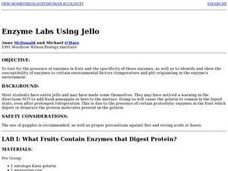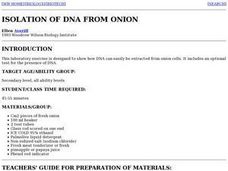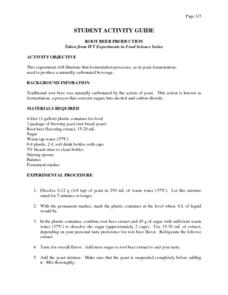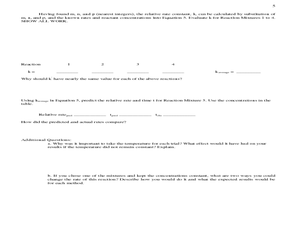Curated OER
Straw Chromatography
High schoolers separate food coloring using liquid chromatography. For this chemistry lesson, students explain the effects of different solvents on the rate of separation.
Curated OER
Gases and Chemical Reactions
In this chemical reactions worksheet, students calculate the volume or pressure for different gases. Students determine the effect of different stimuli on the rate of a chemical reaction. This worksheet has 1 short answer, 10 fill in the...
Curated OER
Enzymes and Jell-O
Learners test for the presence of enzymes in fruit and the specificity of those enzymes. They identify the susceptibility of enzymes to certain environmental factors such as temperature and pH in the enzymes environment.
Curated OER
Chemistry: Knowledge Quiz
In this chemistry quiz worksheet, students complete a set of 10 multiple choice questions covering a variety of chemistry concepts.
Curated OER
Can You Control Floods
Students assume the role of an engineer or planner. As an engineer or planner they must come up with ideas that can be put into place to control floods. They produce a working model of flood control.
Curated OER
Making Slime: An Exercise in the Scientific method
Students make a polymer but they won't be getting instructions. They'll get materials and they must figure it out on their own and report the actual steps needed back to the teacher.
Curated OER
ISOLATION OF DNA FROM ONION
Students perform a laboratory exercise designed to show how DNA can easily be extracted from onion cells. They conduct an optional test for the presence of DNA using standard lab equipment.
Curated OER
Monomer and Polymer Chemistry
Students explain monomer/polymer chemistry of starches and sugars.
Curated OER
Root Beer Production
In this fermentation worksheet, students conduct an experiment to illustrate how the yeast fermentation process is used to produce carbonation. This worksheet has 5 short answer questions.
Curated OER
Coal Flowers
Students create coal flowers. In this mining lesson, students discuss the importance of coal during the 1800s and use ingredients to make coal flowers. Students determine the effect temperature has on crystal formation.
Curated OER
Observing the Effect of a Change in Conditions on a System at Equilibrium by Applying Le Chatelier's Principle
Young scholars describe the Le Chatelier Principle. They participate in an experiment in which they observe the changes in an equilibrium system. They answer discussion questions to end the lesson.
Curated OER
A Clock Reaction
This is an advanced rates of reactions learning exercise. Students will be determining reaction times, molarities, and reactions rates for different reactions.
Curated OER
How To Culture Bacteria in the Laboratory
Students participate in an experiment in which they culture bacteria in a lab setting. They record their observations and analyze the data. They answer comprehension questions to end the lesson plan.
Curated OER
Rainbow Electrophoresis
Students are introduced to the principles of gel electrophoresis and also provides an opportunity for students to practice loading gels and prpetting. In this laboratory activity, food color is used to separate into constituent pigments.
Curated OER
Composting in Schools: Observing Compost Microorganisms
Students explore composting. In this composting lesson, students use compound microscopes to observe the microbial communities in compost. Observations and documentation of changes will occur over the course of several weeks.
Curated OER
Make A Crystal Snowflake!
Students make a crystal snowflake decoration out of string, pipe cleaners, food coloring, boiling water, and more. In this snowflake lesson plan, students let it dry over night and see crystals in the morning.
Curated OER
Salt Water Wedge
Students conduct an experiment to observe the properties of both salt and freshwater. They explain why freshwater will stay at the surface while salt water will travel up a river bottom because of density. Students also research the...
Curated OER
Making Paint
Students discover how paint is made, then create their own paint which they will use to create a picture. After witnessing the processes of emulsion and suspension, students work in groups to create their own paint, and then create...
Curated OER
Making A Natural pH Indicator
Students make their own pH indicator from red cabbage. Red cabbage contains a chemical that turns from its natural deep purple color to red in acids and blue in bases. Students boil the cabbage to get the pH indicator.
Curated OER
Chlorophyll
Middle schoolers use thin layer chromatography, TLC, to separate various pigments found in plants.
Curated OER
Activity #14 Floating Bubbles
Learners comprehend that Carbon dioxide gas is relatively easy to generate. They comprehend that one way to produce it is with dry ice. Pupils comprehend that carbon dioxide gas can also be produced by combining baking soda with vinegar.
Curated OER
Soil Chemistry Challenge
In this soil chemistry learning exercise, students complete the sentences with the correct words to fill in the blanks about soil chemistry. Students complete 28 blanks.
Curated OER
Ice Cream
Students explore the concept of the colligative property. Through experimentation, students lower the freezing point of a liquid in order to create a solid by using household ingredients to create ice cream.
Curated OER
Plant And Animal Cells
Students identify parts of plant and animal cells and describe the functions of each part. They distinguish between plant and animal cells. After a lecture/demo, students perform experiments which help them construct models of plant and...

























